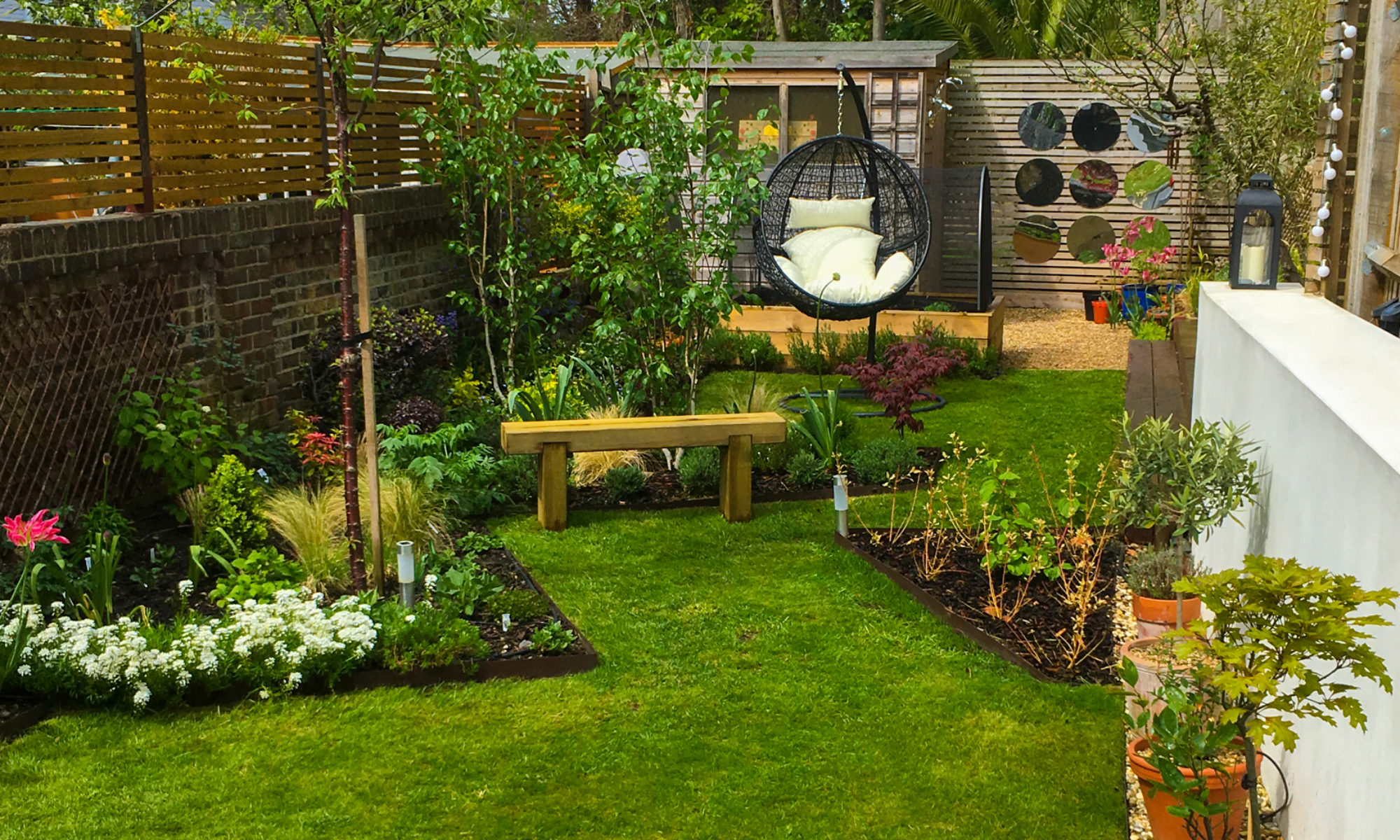I have paused publishing my blog posts here. You can find them on Instagram instead: follow @heidiwalthergardens for garden design tips, trend reports and news from my business. See you there!
Lockdown Gardening
We have reached the home stretch of the growing season, and what a season it has been! I’ve had a busy and exciting first year as a landscape designer in Seattle (it’s not over yet!), and would like to share some observations.
When I first meet with new clients, via phone or Zoom, their stories this year have been quite similar: “We are at home more and would like to turn our yard into a more inviting space.” or “I’m walking around the neighborhood a lot these days and admiring all the beautiful gardens. I wish mine would be more attractive.” or “We’re not going anywhere this summer. So we’re spending our time and money on our yard.”

For many clients, a kitchen garden is now an integral part of their outdoor space. Some call them Victory Gardens 2.0, or Pandemic Gardens. New name, same idea: supply the home with fresh fruit and veg during times of crisis. I am more than happy to include them in my designs, be it as a fun veg patch for the kids or a stylish potager to enjoy a walk in. My hope is that they will outlast the crisis they were designed for.
Sometimes the kitchen garden thing doesn’t seem to work out though. If that has happened to you, please read on:
It’s perfectly fine to realize after the first year that perhaps you don’t have the keen green thumb you thought you had. Or that you need more space, water and time to feed the family from the fruits of your own garden than you are able to give. Maybe your kids’ enthusiasm only lasted until the first batch of radishes, and now you’re wondering why you bothered?
The good news is, these raised beds are not wasted. If you want to take a pause from growing edibles, grow cutting flowers instead! Dahlias, ranunculus, zinnias, delphiniums… there’s a long list of easily grown plants that will add lots of color to your outdoor and indoor spaces. Or grow some easy herbs. They always come in handy, and the bees love them. Another insect magnet for your raised beds is a wildflower patch, cheaply grown from seed. When one spring you feel like returning to lettuces and tomatoes, go for it!
The Chelsea Flower Show Series: James Alexander-Sinclair. 2017
The final garden in this series is the ‘Throb and Vibe’ garden by English designer JAS, or James Alexander-Sinclair for long. It was created in a year of crisis for Chelsea. The year was 2017, and in the uncertain time after the Brexit referendum, sponsors abandoned the show. No sponsors, no gardens, so JAS stepped in to design a last-minute commission using the theme of sound. No-one can explain the concept and its realization better than the designer himself.
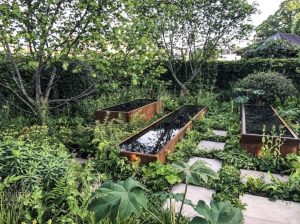
I remember him talking about this garden at an event in Seattle, while Alexander-Sinclair was a guest judge at the Northwest Flower and Garden Show. What a joy it was to listen to his stories! The event in February may very well have been his last trip for a while as now we are faced with another crisis, brought on by a tiny but nasty virus.
Apart from his Chelsea garden, James Alexander-Sinclair brought another project to my attention — Horatio’s Garden. This UK charity supports spinal-injury units of the NHS, for which a number of designers have created marvellous gardens, including JAS. Please visit their website to see what incredible work they do, and how beautiful their gardens look and feel for the people they were designed for.
The virtual Chelsea Flower Show 2020 has started. I’m sure we’ll all enjoy it.
The Chelsea Flower Show Series: MARY REYNOLDS. 2002
In 2002 Mary Reynolds from County Wexford, Ireland, became the youngest ever winner of a gold medal at Chelsea. Her design was called „subversive“, an end to pretty gardens, as it introduced weeds and (allegedly) rabbit droppings to the prestigious Chelsea Flower Show. Imagine the huff and puff at a show that was created by the nursery industry to showcase beautiful flowers in neat settings.
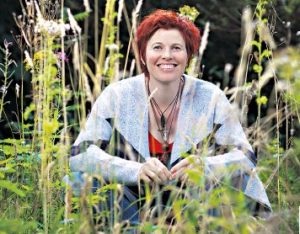
Reynolds‘ garden wasn’t just wild, though. It envoked Irish mythology, with stone thrones arranged in a circle, a circular stone gate through which to enter the garden, and native Irish planting. Her triumph at Chelsea should be understood in the context of the fraught history between Ireland and Britain. Britons used to build the stately gardens in Ireland, bringing with them their plants and their aesthetic. In 2002, Mary Reynolds returned the favour!
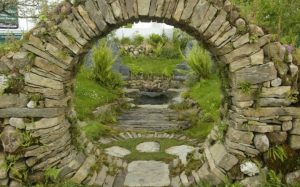

Her approach to planting was revolutionary then, but has become accepted in naturalistic, native plants(wo)man circles. She groups plants into communities that naturally grow together and doesn’t believe in weeding or tilling the soil. For Chelsea she enlisted traditional Irish stonemasons.
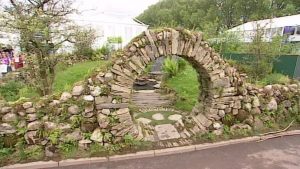
After Chelsea, Mary Reynolds turned environmentalist and can appear as very much an ‘anti-gardener’. It is true that gardens are nature controlled. I would subscribe to this statement. Mary Reynolds wants to free gardens of this control and manipulation, but she says a complete return to wilderness won’t be desirable because it would exclude us humans: “The soil would heal itself. All the little creatures would come back. But something important would be missing: We wouldn’t be part of that process.” It’s spring 2020 and I think I understand.
A biopic about Reynolds, “Dare to Be Wild“, is highly recommended, as is her book “The Garden Awakening”.
Further reading:
The Chelsea Flower Show Series: ARABELLA LENNOX-BOYD. 2000
British-based Arabella Lennox-Boyd was born and raised in Italy, and fortunately, her designs pay tribute to those Mediterranean roots. Her Chelsea garden from the year 2000 is no exception. “A Garden for All Time” was Lennox-Boyd’s fifth garden for the show, and it won her a fifth gold medal. She would go on to win a sixth gold in 2008. A perfect score!
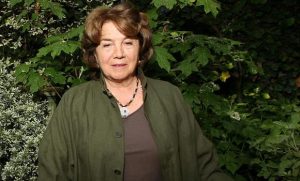
At the time this was supposed to be Arabella’s final Chelsea garden, so you’d expect her to want to go out with a bang. I think her creation delivers. This millennial garden has a very formal, geometric design on paper, which I like a lot. It is also strictly symmetrical, possibly a nod to Italian Renaissance gardens, with an impressive focal point: “Clearwater Cube”, a giant stainless steel frame and cube installation by water sculptor William Pye.

It’s the planting that drew me in more than the statement sculpture though. The planting shows an unmistakable Italian flavour. Tall slender cypresses along with six huge, ancient gnarled olive trees instantly conjure the atmosphere in a contrasting formal setting. The olive trees are set on square islands in a water feature surrounding the central lawn. I can picture myself hopping across the water to sit on the grass, taking in the calm land- and soundscape around me. Richly planted perennial borders, using Mediterranean style plants, but planted densely in a very English style, are matched with quieter plantings at the rear of the garden. Traditional and modern, English and Italian, are seamlessly integrated.
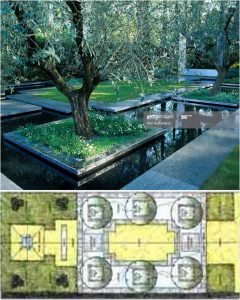
This garden touched me at a time when me and my husband were discovering our love for Italy and looking for a place there. We searched up and down the country and eventually found a piece of Italy that had the views, the people and the promise we were looking for. As I am developing my personal style, the mix of English planting exuberance and Mediterranean structure is an inspiring model to take guidance from.
Further reading:
https://www.hortweek.com/arabella-lennox-boyd-garden-designer/parks-and-gardens/article/794056
The Chelsea Flower Show Series: JOHN BROOKES. 1962
May is Chelsea time. The Chelsea Flower Show is the most prestigious garden event in the world. It is where we landscape designers can be artists building our own dream gardens, not our clients‘. This year because of the pandemic, the show is cancelled, a virtual programme is being planned.
In this series I want to celebrate five garden designers and their award-winning gardens leading up to the flower show. The five I chose have influenced me and my development in one way or another. I hope you‘ll find their very different styles as inspiring as I do.
I am beginning my list with the landscape designer I was closest to though we never met. John Brookes MBE won three gold medals in a row at Chelsea (and several more), and is known as “the man who made the modern garden”. He introduced the concept of the “room outside” to landscape design, while specialising in small urban gardens early in his career and noticing that people liked to use their outdoor spaces for eating and entertaining, not just for collecting flowers.

When Brookes was chosen to design a garden for Chelsea in 1962, he was the first independent designer to build an exhibition garden at a show that was dominated by floral nursery displays. This was groundbreaking in itself, but his design certainly broke the mould. The garden was shown in relation to the house, displayed a combination of form and function, had “ugly” practical elements such as room for an incinerator. It was visionary but perhaps a little too much so. The judges awarded Brookes a timid silver medal.
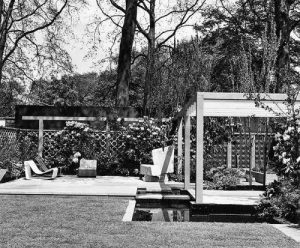

John Brookes based his designs on patterns and proportions. He used a grid system derived from measurements of the house, and applied it to interlocking, overlapping patterns on paper. As a result, his 1962 Chelsea design plan looks like a modernist painting. Doesn’t it remind you of a Mondrian?
I learned this technique from him in an online class I took before I even started my formal design education. Brookes wasn’t a household name then unlike other Chelsea winners, so I had the incredible good fortune to be the only student in his class! And so, this amazing one-on-one tutorial resulted in my first ever garden being co-designed by John Brookes MBE.
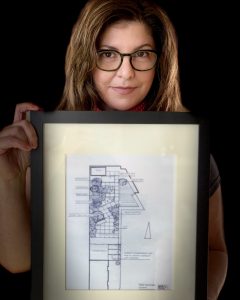
Further reading:
https://garden-design-courses.co.uk/john-brookes/
https://www.ft.com/content/5a39f558-372f-11e8-8eee-e06bde01c544
The Beauty Test For Your Planting
Have you ever wondered why you like the look of one border more than another? Both are equally colorful, both have exciting plants, but one is just so much more pleasing to look at. Why is that? In a workshop a couple of years ago, Noel Kingsbury and Piet Oudolf taught me about their rules for successful (read: stunning) perennial planting combinations. You may be surprised to learn that the secret is not so much color, but shape.
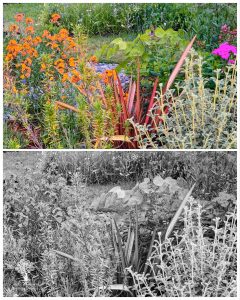
How does the “beauty test” work? From Piet Oudolf I learned this neat trick: take a photo of a planting you like. Then make that photo black&white. Is the planting still as attractive as it was in color? It should be. If it isn’t, there may be too much emphasis on color combinations, and not enough on plant shapes and textures. You can apply this test to plant arrangements directly in the nursery, before you buy.
Why is shape so important? Color, especially flower color, is fleeting. Plant shapes last longer, in the case of evergreens throughout the seasons. And let’s not forget the seed heads which can give a perennial a whole new seasonal interest. Take phlomis or eryngium, for example, which I think are at their most impressive in late summer. That’s why shape should come before color when putting together a plant scheme, no matter how colorful you want your palette to be. Which is not to say color is not important, of course, and I will talk about color in another post.
Here is a beauty test example: look at the black&white image I have included in this post. You can see that the combination of evergreens on the right hand side — ballota, phormium and epimedium — has distinctive, contrasting shapes that create visual interest. Meanwhile the plants over on the left all seem to blur into one. I could add a more contrasting plant there, perhaps in the shape of an agapanthus, or a compact evergreen shrub, or simply another phormium.
Have fun making your garden photos black&white and discovering shapes you may not have noticed before!
My Power Plants
Every designer and gardener has a number of trusted plants that they rely on to add lasting joy and value to any planting scheme. I call them Power Plants. This is an (incomplete) selection of mine.
1. Geranium ‘Rozanne’
When we rented our London house (and garden) to professional people, we did not appreciate just how uninterested our tenants were in even the most basic gardening. The result: all perennials perished after a year of snow followed by drought followed by torrential rain. All perennials, that is, except Geranium ‘Rozanne’. When even the boxwood had given up, the geraniums kept flowering in purple abundance all the way through October. Geranium ‘Rozanne’ is the plant for those with zero green fingers.

2. Pittosporum ’Tom Thumb’
Shrubs give structure to a planting scheme. Evergreen Pittosporum ‘Tom Thumb’ is no exception. I love this shrub and prefer it to buxus because it keeps its shape over a long period of time. Even if like me, you one day decide to clip a row of pittosporums into cubes, pyramids and eggs. The ‘Tom Thumb’ variety has a beautiful dark bronze colour which makes it a great backdrop for bright green foliage and white flowers. In spring it displays very charming green new growth of its own.
3. Cornus sanguinea ‘Midwinter Fire’
Cornus in the garden makes me look forward to winter. Nothing packs a punch quite like a cloud of this variety of dogwood shrubs with its fiery orange-red branches. Cornus happily tolerates wet feet, is therefore ideal for the centre of a rain garden or areas of poor drainage. No winter garden should be without it.
4. Geum
You cannot have a spring-summer border without geums. Chances are you have one of their many many varieties in your garden already. Geums are the plant that keeps on giving, each little plant capable of producing hundreds of bright and delicate insect-magnets (aka flowers) per season. A real trouper.
5. Stipa tenuissima
I call stipas the blue jeans of the plant world. They go with absolutely everything. With elegant lilies or common milkweed, even with other grasses. Nothing provides more movement in a sweltering summer garden than a drift of Stipa tenuissima.
As I said in the beginning, this list is by no means complete, and I might publish part 2 soon.
Tell me about your Power Plants!
Quickstart Your Yard!
I am excited to announce a new service for clients in and around Seattle!
Quickstart Your Yard! is a personal 90-minute coaching session designed for those seeking ideas to transform their yards without investing in a full-scale construction project right away. In our conversation I will give sound, practical advice to my clients and will share insights into how they can make the most of their outdoor living spaces.
When I moved with my family from London to Seattle, I had to learn about the diverse and unique plant world of the Pacific Northwest. It was a lot to take in in a short space of time. I did not know what grows in this zone (in fact I didn’t know about USDA hardiness zones at all before I moved here), had no idea about good local suppliers for plants and materials. Since then I have traveled around the PNW, have met with horticultural experts and wildlife champions, attended workshops and of course connected with suppliers and contractors as part of my design business. My membership in landscape and horticultural organizations enables me to keep up with latest trends and standards.
By offering this coaching session I want to share with Seattle homeowners (or landlords & renters!) my insights as an international landscape designer and my knowledge of gardening in the PNW.
To book a Quickstart Your Yard! session with me, Heidi, please contact me via the contact form on this website.
Moodboards
During a recent phone conversation with a new client: I was explaining the stages of our collaborative design process — questionnaire, consultation, briefing including any ideas by my client. „Photos collated in a moodboard are great“, I said, when he stopped me and asked, „what’s a moodboard?“
A collage of photos or any other illustrations that convey the look you wish to achieve for your yard, that’s what is called a moodboard. As a landscape designer I use them all the time, in two design phases. Clients have given me collages of magazine cuttings, or powerpoint slides of pinterest and instagram pics, to describe their initial ideas. These moodboards can include plants, paths, decks, furniture, planters… any desirable design element that has caught my client’s attention, it may even be the neighbour‘s garden.
At this early stage, a moodboard is an incredibly helpful tool to define the project scope, and serves as a basis for our conversation. They make a second appearance later in the design process. Once I have created a concept plan, I add my own moodboard as part of the design visualisation, along with the plan drawing and possibly a number of elevation views. Because when a client can understand the design, they have the confidence to buy into it.
